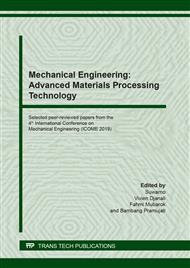[1]
J. Kong, R. Ning, and Y. Tang, Study on modification of epoxy resins with acrylate liquid rubber containing pendant epoxy groups, J Mater Sci. 41 (2006) 1639–1641.
DOI: 10.1007/s10853-005-1862-6
Google Scholar
[2]
T. Adachi, M. Osaki, W. Araki, et al., Fracture toughness of nano- and micro-spherical silica-particle-filled epoxy composites, Acta Mater. 56 (2008) 2101–2109.
DOI: 10.1016/j.actamat.2008.01.002
Google Scholar
[3]
J. Lee, and A.F. Yee, Role of inherent matrix toughness on fracture of glass bead filled epoxies, Polymer 41 (2000) 8375–8385.
DOI: 10.1016/s0032-3861(00)00186-5
Google Scholar
[4]
S. Sugiman and S. Salman, Hygrothermal effects on tensile and fracture properties of epoxy filled with inorganic fillers having different reactivity to water, J Adhes Sci Technol. 33(7) (2019) 691-714.
DOI: 10.1080/01694243.2018.1558492
Google Scholar
[5]
S.K. Singh, S. Singh, A. Kumar, et al., Thermo-mechanical behavior of TiO2 dispersed epoxy composites, Eng Fract Mech. 184 (2017) 241–248.
DOI: 10.1016/j.engfracmech.2017.09.005
Google Scholar
[6]
Sugiman, and P.D. Setyawan, Surface treatment of fly ash for improving the tensile strength of fly ash/unsaturated polyester composites, Makara Technology Series 17(3) (2013) 128-132.
DOI: 10.7454/mst.v17i3.2932
Google Scholar
[7]
S. Sugiman, S. Edy, A.D. Catur, and Salman, Effect of fly ash volume fraction on the shear strength of adhesively bonded steel joints, AIP Conference Proceedings 1983 (2018) 050006;.
DOI: 10.1063/1.5046279
Google Scholar
[8]
ASTM D638-02ª, Standard test method for tensile properties of plastics, ASTM International, Pennsylvania, (2007).
Google Scholar
[9]
H.G. Carter, and K.G. Kibler, Langmuir type model for anomalous moisture diffusion in composite resins, J Compos Mater. 12 (1978) 118-131.
DOI: 10.1177/002199837801200201
Google Scholar
[10]
G. Capiel, J. Uicich, D. Fasce, and P.E. Montemartini, Diffusion and hydrolysis effects during water aging on an epoxy anhydride system, Polym Degrad Stabil. 153 (2018) 165-171.
DOI: 10.1016/j.polymdegradstab.2018.04.030
Google Scholar
[11]
A.J. Kinloch, Adhesion and Adhesives: Science and Technology, Chapman & Hall, London, (1994).
Google Scholar
[12]
H. Ogihara, J. Xie, and T. Saji, Controlling surface energy of glass substrates to prepare superhydrophobic and transparent films from silica nanoparticle suspensions, J Colloid Interf Sci. 437 (2015) 24–27.
DOI: 10.1016/j.jcis.2014.09.021
Google Scholar
[13]
H. He, J. Yang, W. Huang, et al., Influence of nano-calcium carbonate particles on the moisture absorption and mechanical properties of epoxy nanocomposite, Adv Polym Technol. 0 (2016) 1–6.
DOI: 10.1002/adv.21751
Google Scholar
[14]
H. Alamri, and I.M. Low, Effect of water absorption on the mechanical properties of n-SiC filled recycled cellulose fiber reinforced epoxy eco-composites, Polym Test. 31 (2012) 810–818.
DOI: 10.1016/j.polymertesting.2012.06.001
Google Scholar
[15]
B. Stuart, Infrared Spectroscopy: Fundamentals and Applications, John Wiley & Sons, Ltd, (2004).
Google Scholar
[16]
https://chem.libretexts.org/Ancillary_Materials/Reference/Reference_Tables/Spectroscopic_Parameters/Infrared_Spectroscopy_Absorption_Table (accessed on 30 Juni 2019).
Google Scholar
[17]
R.E. Farsani, S.M.R. Khalili, and V. Daghigh, Charpy impact response of basalt fiber reinforced epoxy and basalt fiber metal laminate composites: experimental study, Int J Damage Mech. 0 (2013) 1–16.
DOI: 10.1177/1056789513511976
Google Scholar
[18]
S. Zhao, L.S. Schadler, R. Duncan, et al., Mechanisms leading to improved mechanical performance in nanoscale alumina filled epoxy, Compos Sci Technol. 68 (2008) 2965–2975.
DOI: 10.1016/j.compscitech.2008.01.009
Google Scholar
[19]
A.J. Kinloch, and R.J. Young, Fracture Behaviour of Polymers, Applied Science Publishers, London, (1983).
Google Scholar
[20]
E.S. Greenhalgh, Failure Analysis and Fractography of Polymer Composites, Woodhead Publishing Limited and CRC Press LLC, Cambridge, (2009).
Google Scholar
[21]
J. Spanoudakis, and R.J. Young, Crack propagation in a glass particle-filled epoxy resin. Part 2 Effect of particle-matrix adhesion, J Mater Sci. 19 (1984) 487–496.
DOI: 10.1007/bf02403235
Google Scholar
[22]
V. Kushvaha, and H. Tippur, Effect of filler shape, volume fraction and loading rate on dynamic fracture behaviour of glass-filled epoxy, Composites: Part B. 64 (2014) 126–137.
DOI: 10.1016/j.compositesb.2014.04.016
Google Scholar


